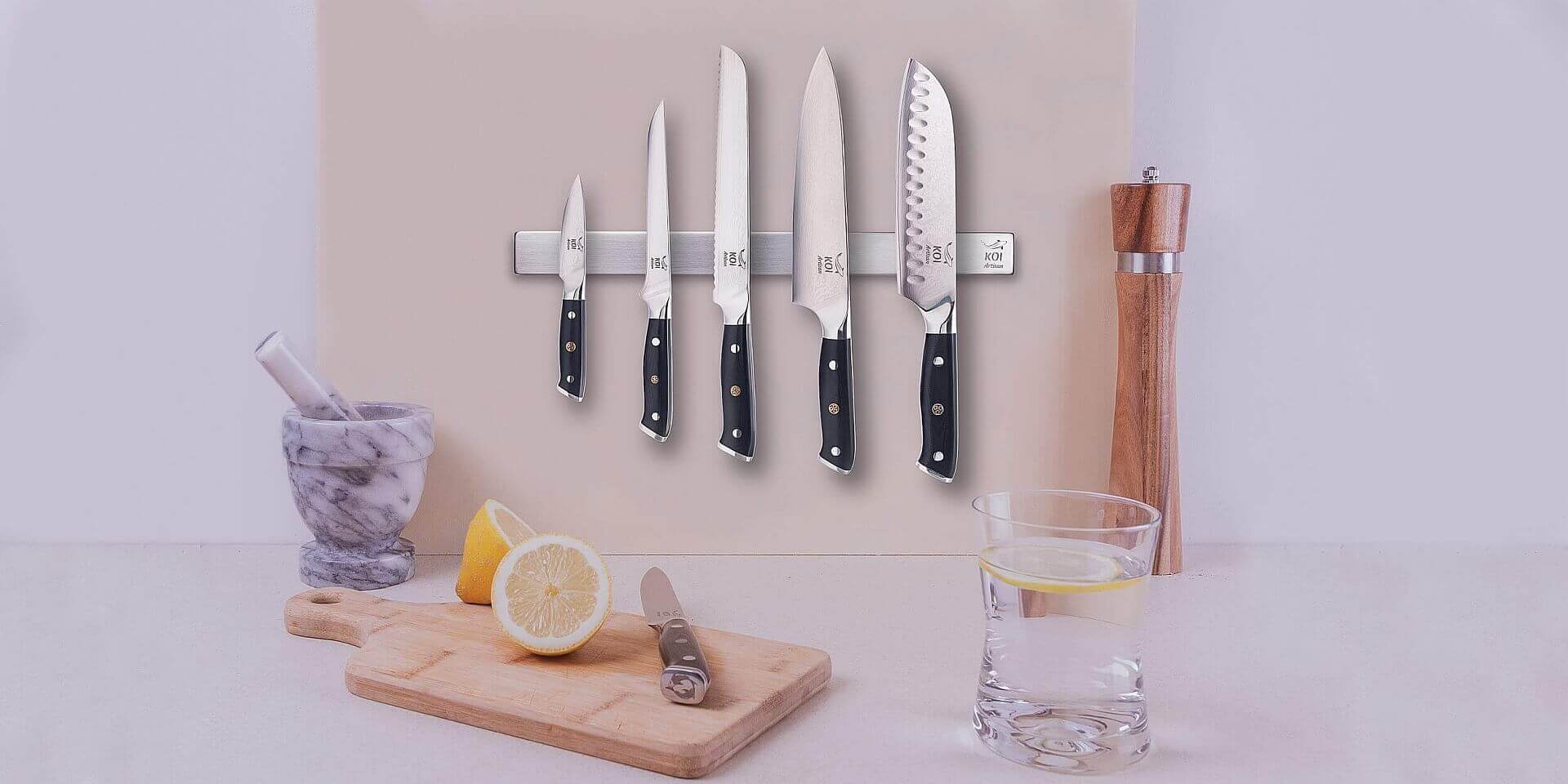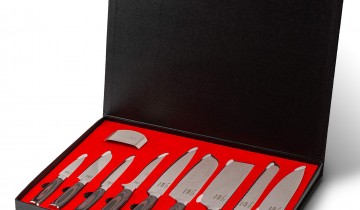A fascinating look at the origins and evolution of kitchen knives throughout history, including the materials and techniques used to make knives in ancient times and how knives have changed over the centuries.
Kitchen knives have been essential tools for preparing food for thousands of years. The history of kitchen knives is a fascinating tale of innovation, craftsmanship, and cultural influences.
The earliest knives were likely made from sharpened stones, bones, or shells. These primitive tools were used for hunting, but they also served a vital role in preparing food. As humans transitioned to agriculture and settled in one place, they began to create more specialized knives for specific tasks, such as cutting meat or chopping vegetables.
In ancient Egypt, kitchen knives were made from bronze and later iron. These knives had a single cutting edge and a curved blade, which made them well-suited for slicing and chopping. The ancient Greeks and Romans also used knives extensively in their kitchens and dining rooms. Roman kitchen knives were often made from high-quality steel and featured ornate designs on the handle.
During the Middle Ages in Europe, kitchen knives were made by local blacksmiths using a variety of materials, including steel, iron, and bone. These knives were often very basic in design and lacked the sharpness and precision of modern kitchen knives. However, they were still effective tools for preparing food.
It wasn’t until the 18th century that kitchen knives began to be manufactured on a large scale. This was thanks in part to advancements in technology, such as the development of steelmaking techniques that allowed for stronger and sharper blades. In the 19th century, German knife manufacturers began producing high-quality kitchen knives, which quickly gained a reputation for their durability and sharpness.
The 20th century saw the rise of Japanese kitchen knives, which are known for their precision and sharpness. Japanese knives are often made from high-carbon steel and feature a thinner, sharper blade than their Western counterparts. Today, many professional chefs swear by Japanese knives for their precision and sharpness.
In recent years, there has been a resurgence of interest in traditional and handmade kitchen knives. Many artisanal knife makers are creating high-quality knives using traditional techniques and materials, such as Damascus steel and exotic hardwoods. These knives are prized for their beauty and craftsmanship, as well as their effectiveness in the kitchen.
In conclusion, the history of kitchen knives is a long and fascinating one, spanning thousands of years of human history. From the primitive stone knives of ancient times to the high-tech kitchen knives of today, these essential tools have undergone a remarkable evolution. Whether you’re a professional chef or a home cook, a good kitchen knife is an indispensable tool for preparing food.
Japanese chef knives, also known as “hocho,” have a long and rich history that dates back to the medieval period. The craft of knife-making in Japan is known as “wazashu,” which means “the art of sharpening.” This tradition has been passed down from generation to generation, resulting in some of the finest and most respected knives in the world.
The earliest Japanese chef knives were made in the Kamakura period (1185-1333) and were designed for slicing raw fish and vegetables. These knives, known as “debabocho,” had a thin, sharp blade that was perfect for making precise cuts. They were made from a combination of iron and steel, which gave them strength and durability.
In the Edo period (1603-1867), Japan was closed off from the rest of the world, which allowed the country’s knife-makers to develop their craft in relative isolation. During this time, Japanese knives began to take on distinct shapes and characteristics. The most famous of these is the “santoku,” which means “three virtues” in Japanese. This knife is known for its versatility and is used for slicing, dicing, and chopping.
In the Meiji period (1868-1912), Japan opened up to the world and began to adopt Western technology and methods. This had a significant impact on the country’s knife-making industry, as Japanese knife-makers began to incorporate Western-style handles and materials into their knives.
In the 20th century, Japanese chef knives became increasingly popular in the West, particularly among professional chefs. Japanese knives are known for their sharpness, precision, and durability. They are often made from high-carbon steel, which is harder than the stainless steel used in Western knives. This makes them easier to sharpen and maintain, but also more prone to chipping and rusting.
Today, there are many different types of Japanese chef knives, each with its own unique characteristics and uses. Some of the most popular include the santoku, the gyuto (Japanese version of the Western chef’s knife), the nakiri (used for chopping vegetables), and the yanagiba (used for slicing raw fish).
In conclusion, the history of Japanese chef knives is a testament to the country’s dedication to craftsmanship and attention to detail. These knives have been refined over centuries to become some of the finest and most respected in the world. Whether you’re a professional chef or a home cook, a Japanese chef knife is an essential tool in any kitchen.
The santoku knife is a Japanese chef’s knife that has become increasingly popular in Western kitchens in recent years. The word “santoku” means “three virtues” or “three uses” in Japanese, referring to its versatility in chopping, slicing, and dicing. The history of the santoku knife dates back to the mid-20th century, when it was developed as a general-purpose kitchen knife that could perform multiple tasks.
The santoku knife was first created in Japan in the 1940s, during a time when the country was recovering from World War II. At the time, Japan was experiencing a shortage of steel, which meant that knife-makers had to find new ways to create high-quality knives. The santoku knife was designed as a solution to this problem, using a thinner blade and a different cutting edge angle than traditional Japanese knives.
The santoku knife was specifically designed to be a general-purpose kitchen knife that could handle a variety of tasks. It was intended to be used for slicing, dicing, and chopping meat, fish, and vegetables. The blade is typically between 5 and 8 inches long and has a flat cutting edge with a slight curve at the tip. The blade is also wider than most Japanese knives, which makes it easier to scoop up ingredients and transfer them to a plate or bowl.
The popularity of the santoku knife began to spread beyond Japan in the 1990s, as more and more Western chefs began to discover its versatility and practicality in the kitchen. The knife’s popularity was also helped by its appearance on cooking shows and in cooking magazines, where it was often praised for its ability to handle a variety of tasks with ease.
Today, the santoku knife is a staple in many Western kitchens, particularly among home cooks who are looking for a versatile and easy-to-use kitchen knife. While it may not have the same level of history and tradition as some other Japanese knives, the santoku knife has quickly become a favorite of many chefs and home cooks alike for its practicality and versatility in the kitchen.
The utility knife is a versatile kitchen tool that has a long and interesting history. It is a small knife with a blade typically ranging from 4 to 7 inches in length, and is designed to be used for a variety of tasks in the kitchen.
The utility knife has its origins in the early 20th century, when German and French knife-makers began to develop smaller, more versatile knives for use in the kitchen. These knives were intended to be used for a variety of tasks, such as slicing, dicing, and chopping, and were designed to be smaller and more agile than traditional chef’s knives.
One of the earliest and most popular utility knives was the “petty knife,” which originated in Japan. The petty knife was a small, lightweight knife with a thin blade that was perfect for precise cuts and delicate tasks. It was particularly popular among sushi chefs, who used it to slice raw fish and vegetables with precision.
In the mid-20th century, the utility knife began to gain popularity in the United States, particularly as more and more home cooks began to take an interest in cooking. The knife was seen as a practical and versatile tool that could handle a variety of tasks, from slicing meat to chopping vegetables.
Today, the utility knife is a staple in many kitchens around the world. It is particularly popular among home cooks who are looking for a versatile and easy-to-use knife that can handle a variety of tasks. The utility knife is often used in conjunction with a larger chef’s knife, and is particularly useful for tasks that require precision and control, such as trimming meat or peeling vegetables.
In conclusion, the history of the utility knife is a testament to the importance of versatility and practicality in the kitchen. This small but mighty knife has been used for a variety of tasks throughout its history, and continues to be an essential tool in many kitchens today. Whether you’re a professional chef or a home cook, a utility knife is a valuable addition to your kitchen arsenal.
Bread knives have become an essential tool in the modern kitchen, but their history can be traced back to the 19th century. Prior to the invention of bread knives, bread was typically sliced with a saw or a sharp, serrated knife.
The first bread knife was invented in the late 19th century in Germany by a cutlery company called Friedrich Dick. The knife featured a serrated blade that was designed to slice through crusty bread without crushing it. The serrated blade worked by “sawing” through the bread, rather than using brute force to push the blade through the crust.
In the early 20th century, bread knives began to gain popularity in the United States, particularly as more and more people began to eat sliced bread. Bread knives were seen as a practical and efficient way to slice bread, and quickly became a staple in many American kitchens.
Over time, bread knives evolved to become even more efficient and effective. Today, bread knives are typically made with longer blades, ranging from 8 to 12 inches, that are designed to slice through larger loaves of bread. The blades are also typically serrated, with small teeth that are designed to grip the bread and slice through the crust without crushing the soft interior.
In addition to their use in the kitchen, bread knives have also become a popular tool for outdoor enthusiasts, particularly hikers and campers. The serrated blade is particularly useful for cutting through tough materials like rope and fabric, and the long blade is useful for a variety of outdoor tasks.
In conclusion, the history of bread knives is a testament to the importance of innovation and practicality in the kitchen. This simple but effective tool has been used for over a century to slice through bread and other materials with ease, and continues to be an essential tool in many kitchens around the world. Whether you’re a professional baker or a home cook, a bread knife is a valuable addition to your kitchen arsenal.
The Emergence of Nakiri Knives:
The nakiri knife is a type of Japanese vegetable knife that has been used for centuries in Japanese cuisine. The word “nakiri” means “leaf cutter” in Japanese, which is an apt description of its design, as it has a rectangular blade that is typically around 6-7 inches long and is used for chopping and slicing vegetables.
The origins of the nakiri knife can be traced back to the Edo period in Japan (1603-1868), when the country was experiencing a period of relative stability and prosperity. During this time, Japanese cuisine was evolving and becoming more sophisticated, and the need for specialized knives for different tasks was growing.
The nakiri knife was developed as a response to this need, as it provided a specialized tool for the precise and efficient cutting of vegetables. The rectangular blade of the nakiri knife allows for a more efficient cutting motion than a traditional Western-style chef’s knife, which has a curved blade that is better suited to rocking motions.
Over time, the design of the nakiri knife has evolved to meet the changing needs of Japanese chefs. Today, there are many different variations of the nakiri knife, each with its own unique features and characteristics. Some nakiri knives have a double bevel blade, while others have a single bevel. Some have a rounded tip, while others have a square tip.
Despite these variations, the nakiri knife remains a popular and essential tool in Japanese cuisine, and is valued for its precision, efficiency, and versatility. It has also gained popularity in other parts of the world, as chefs and home cooks have come to appreciate its unique design and functionality.




 No products in the cart.
No products in the cart.